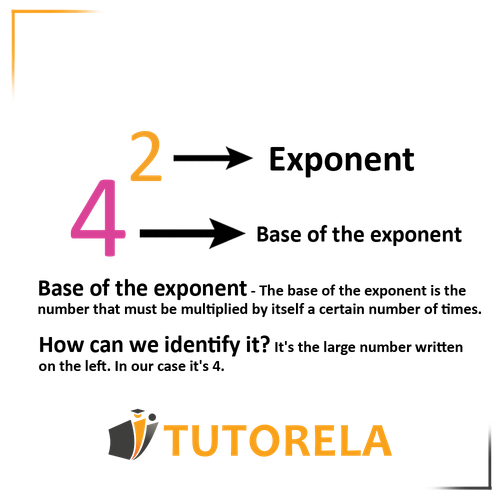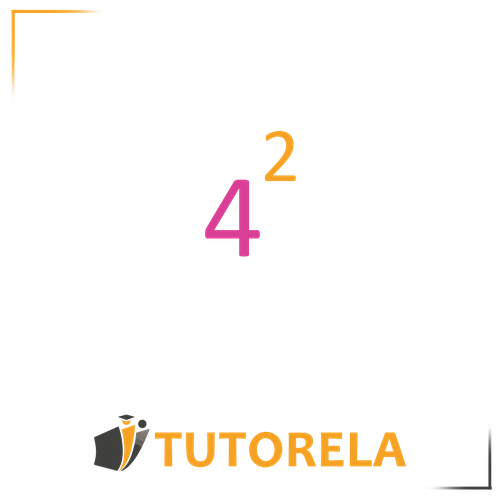An exponent tells us the amount of times a number is to be multiplied by itself.
Exponents and Roots - Basic
Exponents and Roots
What is an exponent?
What is a root?
A root is the inverse operation of exponentiation, which helps us discover which number multiplied by itself gives this result.
The square root is equal to the power of 0.5.

Test yourself on powers and roots - basic!
Which of the following is equivalent to the expression below?
\( \)\( 10,000^1 \)
Powers and roots
What is an exponent?
Exponentiation is the requirement for a number to be multiplied by itself several times.
In other words, when we see a number raised to a certain power, we know that we need to multiply the number by itself several times to reach the actual number.
How do you correctly read a number with an exponent?
Let's learn through an example:

Exponent base – The exponent base is the number that is required to be multiplied by itself a certain number of times.
How do we identify it?
The main number written in large – in our example, this number is .
Exponent – The exponent is the number that determines how many times the base is required to be multiplied by itself.
How do we identify it?
The exponent is the small number that appears to the right above the base – in our example, this number is .
We read it like this: to the power of .
How do you solve an exponent?
To solve an exponent, we need to multiply the base of the exponent by itself the number of times the exponent requires us to.
Let's return to the example:

Base of the exponent =
Exponent =
Let's take the base of the exponent and multiply it by itself times.
We get:
and actually -
Let's practice another example.
How do you solve the following exponentiation:
Solution:
Let's understand what the base and the exponent are.
Base of the exponent =
Exponent =
This means we need to multiply by itself times.
We get:
And actually:
Another example:
Solve the following power:
Solution:
At first glance, we see that the base of the exponent and the exponent itself are identical. Does this change anything for us? Not at all, we work according to the rules.
We multiply the number by itself – for times and get:
And actually –
Another example:
Solve the following power:
We need to take the number and multiply it by itself times. We get:
What would happen if we had such a power?
Would we really need to write the number for times to understand that the result will be in the end?
No.
From this, we can conclude that: to the power of any number equals .
Point to Ponder – What happens when the exponent is ?
When the exponent is , the number does not change at all and it can be considered as if it has already performed the exponentiation.
For example:
Any number to the power of is the number itself.
Another point to consider – what happens when the exponent is ?
When the exponent of the number is , we get a result of . It doesn't matter what the number is.
Any number to the power of will equal .
That means:
What is a root?
A root is equal to the power of and is denoted by the symbol .
We can say that:
A root is the inverse operation of exponentiation.
If a small number appears on the left side, it will be the order of the root.
When any number appears as a regular root, we ask ourselves which number we would need to multiply by itself only twice to get the number inside the root?
In other words, which number raised to the power of will give us the number that appears inside the root.
For example:
If we multiply by itself twice, we get .
Another example:
Solution:
If we multiply the number twice by itself, we get and therefore:
What should you know about roots?
- The result of the square root will always be positive!
You will never get a negative result. We can get a result of . - There is no answer for !
It is important to know - roots and exponents take precedence over all four arithmetic operations.
First, we perform the root and exponentiation operations, and only then do we proceed to the order of operations.
\( 11^2= \)
\( 6^2= \)
\( \sqrt{36}= \)
Examples with solutions for Powers and Roots - Basic
Exercise #1
Which of the following is equivalent to the expression below?
Video Solution
Step-by-Step Solution
To solve this problem, we will apply the rule of exponents:
- Any number raised to the power of 1 remains unchanged. Therefore, by the identity property of exponents, .
Given the choices:
- : This is .
- : Simplifying this expression yields 10,000, which is equivalent to .
- : This results in 20,000, not equivalent to .
- : This results in 0, not equivalent to .
Therefore, the correct choice is , which simplifies to 10,000, making it equivalent to .
Thus, the expression is equivalent to:
Answer
Exercise #2
Video Solution
Step-by-Step Solution
To solve this problem, we'll follow these steps:
- Step 1: Set up the multiplication as .
- Step 2: Compute the product using basic arithmetic.
- Step 3: Compare the result with the provided multiple-choice answers to identify the correct one.
Now, let's work through each step:
Step 1: We begin with the calculation .
Step 2: Perform the multiplication:
- Multiply the units digits: .
- Next, for the tens digits: .
- Add the results: . This doesn't seem right, so let's break it down further.
Let's examine a more structured multiplication method:
Multiply by (last digit of the second 11), we get 11.
Multiply by (tens place of the second 11), we get 110.
If we align correctly and add the partial products:
11
+ 110
------------
121
Step 3: The correct multiplication yields the final result as . Upon reviewing the provided choices, the correct answer is choice 4: .
Therefore, the solution to the problem is .
Answer
121
Exercise #3
Video Solution
Step-by-Step Solution
To solve this problem, we'll follow these steps:
- Step 1: Recognize that means .
- Step 2: Perform the multiplication of 6 by itself.
Now, let's work through each step:
Step 1: The expression indicates we need to multiply 6 by itself.
Step 2: Calculating gives us 36.
Therefore, the value of is 36.
Answer
36
Exercise #4
Video Solution
Step-by-Step Solution
Let's solve the problem step by step:
- Step 1: Understand what the square root means.
- Step 2: Apply this definition to the number .
- Step 3: Determine the correct number.
The square root of a number is a value that, when multiplied by itself, equals . This is written as .
We are looking for a number such that . This translates to finding .
We know that . Therefore, the principal square root of is .
Thus, the solution to the problem is .
Among the given choices, the correct one is: Choice 1: .
Answer
6
Exercise #5
Video Solution
Step-by-Step Solution
To solve this problem, we'll follow these steps:
- Step 1: Recognize what finding a square root means
- Step 2: List known perfect squares to identify which one results in 64
- Step 3: Verify the square root by calculation
Now, let's work through each step:
Step 1: To find the square root of 64, we seek a number that, when multiplied by itself, equals 64.
Step 2: Consider the sequence of perfect squares: , , , , , , , .
Step 3: We see that . Therefore, the square root of 64 is 8.
Therefore, the solution to this problem is .
Answer
8
More Questions
Powers
- Order of Operations: Exponents
- Order of Operations: Roots
- Division and Fraction Bars (Vinculum)
- The Numbers 0 and 1 in Operations
- Neutral Element (Identity Element)
- Order of Operations with Parentheses
- Order or Hierarchy of Operations with Fractions
- Exponential Equations
- Variables in Algebraic Expressions
- The Numerical Value in Algebraic Expressions
- Transposition of terms and domain of equations of one unknown.
- Equivalent Expressions
- Multiplication of Algebraic Expressions
- Simplifying Expressions (Collecting Like Terms)
- Multiplicative Inverse
- Integer powering
- Domain of a Function
- Exponents and Roots - Basic
- What is a square root?
- Square Root of a Negative Number
- Exponents and Exponent rules
- Exponents - Special Cases
- Negative Exponents
- Zero Exponent Rule
- Basis of a power
- The exponent of a power
- Power of a Quotient
- Exponent of a Multiplication
- Multiplying Exponents with the Same Base
- Division of Exponents with the Same Base
- Power of a Power
- Powers
- Order of Operations - Exponents and Roots
- Special cases (0 and 1, reciprocals, fraction line)









